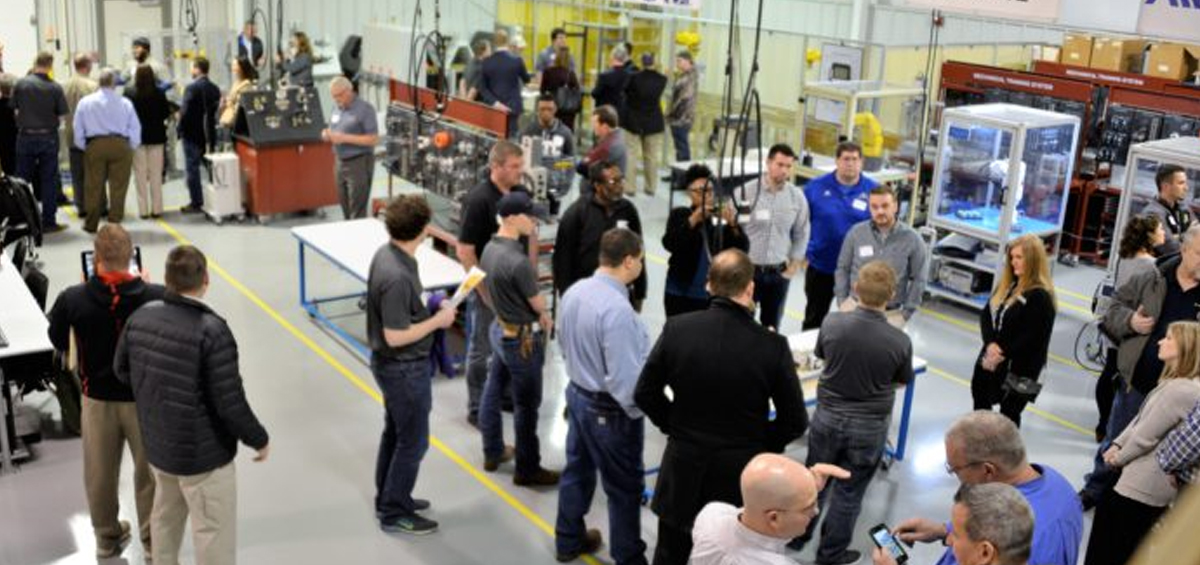
Everyone who has looked at the award-winning Advanced Manufacturing Technician (AMT) career pathway training program agrees — it is turning out excellent, highly-skilled workers who are smart and capable problem-solvers.
And while the program is helping local businesses in nine states create a pipeline of much-needed talent, there is still work to be done. Hundreds of students have graduated from the program, a fraction of the estimated 2 million workers that will be needed in manufacturing by 2025. The Federation for Advanced Manufacturing Education (FAME)—a collaborative group of manufacturers who sponsor the program—hopes to entice other businesses to adopt the model.
AMT Live! — a day-long “Go-and-Visit” at State Technical College of Missouri in St. Charles on February 21 — gave prospective partners a walkthrough of the program while introducing them to the curriculum, employers, teachers and the students taking part in the training. The five-semester intensive program was developed and implemented by Toyota Motor North America at its plant in Kentucky.
AMT Founder Dennis Dio Parker led the show-and-tell event, which highlighted the three prongs of the training: technology skills, professional behaviors and competitive practices.
The AMT dual track model is two days of classroom and shop learning, then three days of on-the-job training. In the St. Charles program, eight local companies—including Toyota/Bodine, Nike Air Innovations, and SunEdison Semiconductors—sponsor the current class of 14 students, paying them $14-an-hour as they learn their craft. The money they earn can be used to pay off the program’s tuition.
“The average student can graduate in less than two years, nearly debt-free,” according to Chris Lagemann, AMT Department Chair at State Tech, “and expect a great starting salary.”
Graduates who go on to work for one of the sponsor companies can earn between $50,000 a year to $60,000 during their first year of employment, plus benefits. In Missouri, the annual mean salary in occupational jobs is about $62,000, according to the U.S. Department of Labor Bureau of Labor Statistics.
Current students, ranging in age from 18 to 33, fielded questions about what they are learning, and why they joined the AMT program, in the meeting room and again as they guided the dozens of attendees through the hands-on training room. Students also demonstrated some of the coursework which incorporates electronics, electricity, and robotics, and trains them to install, calibrate, and repair manufacturing systems.
Some common questions emerged during the event’s breakout sessions: How do you change the perspective that manufacturing jobs are “second choice” careers in “loud, dirty environments? How do you encourage more young women and minorities to engage in STEM education and careers? How do you convince students, parents, and school counselors that there are career opportunities in 2-year schools, as well as 4-year schools?
There wasn’t a consensus on the answers to these important questions, but it reveals that there are still perception problems when it comes to attracting more students to programs like AMT. Solving the talent shortage problem in manufacturing takes an ecosystem of businesses, academia, governments and nonprofits.
I was able to talk to some of the attendees and we were able to cover many of the key issues brought up at the conference. They also told me what they loved about the progress AMT was making toward a solution to the skills gap in manufacturing.
Sound bytes from the AMT Live! event:
“We have a challenge in front of us to change the perception of what modern manufacturing looks like so that people understand that there is a future here. Part of what we need to talk about is that these are highly-skilled jobs with innovation and critical thinking. They are technology-driven and not just standing on the assembly line punching out the same widget every day. That, unfortunately, is the popular culture view of manufacturing, that it is a dying industry, not a growing industry. We’ve added almost a million jobs over the last year. We need to do a better job talking about it. It’s not white collar and blue collar, it’s new collar jobs. Modern manufacturing is a great opportunity for future workers. We have to talk about it differently, so we can get the workforce we need.”-
–Carolyn Lee, Executive Director, Manufacturing Institute
“We have two bases in Kentucky—Fort Campbell and Fort Knox—and collectively they have about 450 transitioning soldiers a month. They have employment coordinators at each of those facilities that engage with employers. They do a lot of things —job placement right away, and helping those soldiers by identifying education opportunities. At Fort Campbell, about 60 percent of the military that is transitioning has skills that transition into manufacturing. We just started recruiting at that base and already have 15 or 16 who have applied to the AMT program.”
–Josh Benton, Executive Director, Kentucky Workforce Development
“The importance to me is presenting a fuller complement of opportunities to young people. Young people should be offered all of the options (not just 4-year schools) and this program does that. It also solves a big problem in our communities and for our industries and for the nation. One thing that we need to think more about is: how do we achieve some volume; how do we achieve some scale? I think we are on the way to that. This is the best program, but the numbers are daunting.”
–Michael Medalla, Manager, Toyota USA Foundation at Toyota North America
“I like that we found a program model that has been successful in another type of industry to solve problems that we also are looking to solve. The structure they have in place could be replicated for our specific needs. We have a shortage of technicians and pilot. In both of those, the people we get are often short in the skills and attributes we are looking for and we think this program could solve those issue.”
–Martin Kirkwood, Director of Career Pathways, Republic Airline
“This event is incredible. We hear that there is a lot of interest in students being a part of this program and employers expanding the program. One of the parts that need to come together still is how are we able to expand very quickly. We heard there are 350 graduates in the state of Kentucky, for example, and we want to expand that as much as possible. In order to get there, it involves kids getting really excited about STEM at an early age. EverFi is really excited about getting kids excited at the middle school age and show them the pathways, some of the careers, that these corporations have to offer. It’s letting them know what’s available and what the pathway is to getting there, whether it is going to a 4-year college, or getting an associate degree, or going into a program like AMT. I think what we’re learning here is it is a long-term plan, not just getting kids excited at the end, but as early as possible.”
–Julia Asoni, Director of Global Partnerships, EverFi
“We are the Advanced Manufacturing Business (AMB) pathway. When students graduate from the AMT program they seamlessly transfer in Northwood’s bachelor’s degree program in Applied Management, which will provide them with the business acumen, leadership, and management skills to lead in their field. We’re up to about 20 students right now, and we had our first AMB graduate this past fall 2017 and he’s looking to start our master’s degree program in fall of 2018. The AMT students that we have been lucky enough to join our program are very well prepared. I would say they are top-notch students, very high-caliber, very intelligent, very driven and personally motivated, which is great because a lot of them are doing (AMB) online so they need that self-motivation to be successful.”
–James Croan, Director of Operations and Corporate Relations, Northwood University
“I am able to earn an income while I am attending school. My work and my school are connected; one is emphasizing the other. I enjoy problem-solving and I get to do that every day of my job. It really has been a good fit. I know this is going to open the door to a lot of opportunities. As a technician, I know I could relocate anywhere in the country and find employment. Being a female in this industry is very helpful because we certainly need more diversity and I can reach out and encourage more women to be a part of something I really like being a part of.”
–Erin, 33, AMT Student, State Technical College of Missouri
“I have been in college before. I have been in the Marines before, but this is the first time I have seen a path to retirement. I plan to stay in the manufacturing industry and see it through all the changes to come.”
–Tremaine, 30, AMT Student, State Technical College of Missouri
“Realistically, I didn’t know what I wanted to do after high school, so I thought I should get a degree and it would be some kind of stepping stone. I graduated college with a fine arts degree before I started this program. One of the things I like about the program is it touches on all aspects of manufacturing. It gives you a little bit of everything, so you can figure out what you like and don’t like.”
–Tim, 28, AMT Student, State Technical College of Missouri
“I came into the program right out of high school. What I liked about the program was having a job while I was in school learning, having a steady paycheck. It’s pretty good for someone my age. I like the hands-on aspect of the job. I knew I didn’t want a desk job. I didn’t like the little cubicles. I like working with my hands.
–Isaac, 20, AMT Student, State Technical College of Missouri
“I like the hands-on experience you get. Since you are at work three days a week and school two days. When we started the program, they said you will probably get 80 percent of what you’re going to know from the hands-on. The school teaches you how to do it by-the-book and safely, but you have to get the hands-on to really know what you’re doing on the job.”
–Mark, 19, AMT Student, State Technical College of Missouri
“Most kids look at manufacturing plants as dirty, nasty places to work. I guess it used to be. Nowadays, with the new robotics, it’s a great place to work and a great place to grow. We work as a team. We only have four guys on a shift at work. One person gives his opinion, another one will, and we find the best solution.”
–Carter, 19, AMT Student, State Technical College of Missouri
Head to the Federation for Advanced Manufacturing Education and the Advanced Manufacturing Technician Program website to learn more.
Rwad full article by Ramona Schindelheim at WorkingNation.

